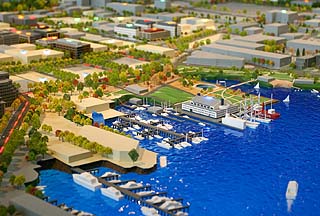|
Subscribe / Renew |
|
|
Contact Us |
|
| ► Subscribe to our Free Weekly Newsletter | |
| home | Welcome, sign in or click here to subscribe. | login |
Real Estate
| |
April 20, 2005
A model neighborhood
Journal Staff Reporter

Photo courtesy Vulcan Inc.
|
If you want to see what Seattle's South Lake Union neighborhood might look like in the future, head to the northwest corner of Denny and Westlake.
There, in a sleek new building, is an elaborately detailed model of the area between the lake and downtown. It took an Arizona company, MICE Marketcraft, more than 4,000 hours to construct the model, which includes 5,000 trees, 4,000 vehicles and 3,000 light posts.
The 16-foot-by-12-foot model shows where the proposed streetcar would run and how the monorail will skirt South Lake Union. Perhaps most important, it gives insight into which parcels Vulcan Inc., owner of 60 acres in the neighborhood, plans to redevelop and when.
But you'll have to wait until April 30 to see it. That's when the 11,000-square-foot South Lake Union Discovery Center opens to the public. Vulcan officials showed the center to the media Tuesday.
Vulcan representatives have said for months the center would be like no other sales center Seattle has seen. At first glance, it appears they're right.
There are virtual reality tours of some of the company's mixed-use developments: Alley 24 and 2200 (both of which are under construction) and the proposed 2201 Ninth Avenue.
There's even a small movie theater that glows to catch the eyes of passersby. Inside the theater is a curved screen wall that opens onto the center at the end of a 5-minute introductory film. The film was shot in South Lake Union and Portland's Pearl District.
Also visible from the street are panels where images are projected, showing area businesses and other images of Northwest life.
A portion of the building houses the sales center for 2200, the $200 million project kitty-corner from the center. There's a model of the three-tower project owned by Vulcan and Milliken Development Group, floor plans and windows showing views from 2200.
The Model Shop of Vancouver, B.C., built the 2200 model, which lets viewers see how the 261 condominiums, Pan Pacific Hotel, Whole Foods Market and other retail will fit together. Kneel down on the Lenora Street side and you can see how architects at CollinsWoerman laid out the courtyard so it has a view corridor from one end of the project to the other. Or how cars will be able to drive onto the courtyard from Terry Avenue.
Vulcan and Milliken officials did not waste the chance to hype 2200, saying it "will set the new standard for development not only in Seattle but across the country," said Vulcan Vice President of Real Estate Ada Healey.
Don Milliken, president of Milliken Development, said, "This development is going to be admired. It's going to be studied. And it's going to be replicated."
Miller/Hull designed the discovery center to be eco-friendly. More than 80 percent of it was built using recycled or what Vulcan officials call environmentally friendly materials.
It can be disassembled into four pieces and moved to a different site if necessary. In addition to making the neighborhood model, MICE Marketcraft designed the center's interior.
The building, which GLY Construction built, has two bioswales. They flank the building, collecting and cleaning rainwater to reduce the amount of water and pollutants flowing into the sewer system.
Despite the center's green features, high-tech gadgets and gleaming surfaces, one can't help but focus on the neighborhood model. How much did the it cost?
"We don't disclose that, but it was well worth it," says Alison Jeffries, Vulcan's real estate marketing manager.


